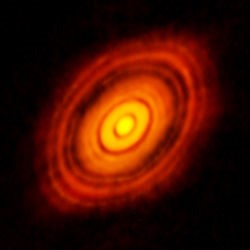Protoplanetary disks, the cradle of planets, contain a large amount of building blocks for planet formation -- (sub)millimeter-size solid particles -- pebbles. Yet, how, when, and where planets start to form is an outstanding question. In the past decade, through the Atacama Large Millimeter/submillimeter Array (ALMA) in Chile, it was revealed that a large number of protoplanetary disks are ringed. Rather than smoothly distributed over the disk, pebbles tend to be concentrated in one or more annular ring structures.
Based on the latest insights in planetesimal formation, pebble accretion, and using the REBOUND N-body framework, we have calculated the potential for these rings to spawn planets. It turns out that conditions for pebble accretion are ideal in these rings, offering an opening for planet formation at large distances. A baby “seed” planet formed in the ring quickly grows by consuming the pebbles in the ring. Depending on the nature of the ring, two distinct outcomes are possible. If the planet stays trapped in the ring, it will grow fat and destroy it. On the other hand, if the planet can migrate inwards, it leaves room for one of its smaller siblings to grow. As a result, a chain of planets can form inside the disk. This is the situation depicted in the space-time figure above, where multiple planets, depicted by black lines, leave the ring.
Our results may offer new insights into the relationship between planets and these ALMA rings. It is widely believed that ALMA rings are a consequence of dynamical sculpting by a planet interior to it -- that is, the planet must arrive first. Yet, in our previous work, we present an alternative explanation for the origin of these dust substructures, invoking only dust-gas aerodynamical interaction -- without the need for a planet. In this picture, pebble rings are simply a manifestation of an aerodynamic pile-up of dense pebble clumps.
Our recent work shows that for this model multiple planets can form from these rings, in a timely manner and without necessarily destroying the rings. In this view, ringed disks are the cradle from which present-day planetary systems containing massive planets form. Rings and planets, chickens or eggs? The game is only on!

ALMA image of the protoplanetary disc around HL Tau.
Credit: ALMA (ESO/NAOJ/NRAO)

The growth trajectories (solid lines) of protoplanets in one of our models. The x-axis is the distance from the host star, and the y-axis is the time. The color of the lines corresponds to the inclination of the protoplanets. The line width is linear with the mass of the planet. The cyan background depicts the background density of planetesimals failing to grow. The two gray vertical lines mark the ring's location and width. Planets formed in the ring, migrate inwards one by one.
Efficient planet formation by pebble accretion in ALMA rings
Jiang, Haochang; Ormel, Chris
https://ui.adsabs.harvard.edu/abs/2022MNRAS.tmp.3135J/abstract
Survival of ALMA Rings in the Absence of Pressure Maxima
Jiang, Haochang; Ormel, Chris
https://ui.adsabs.harvard.edu/abs/2021MNRAS.505.1162J/abstract


